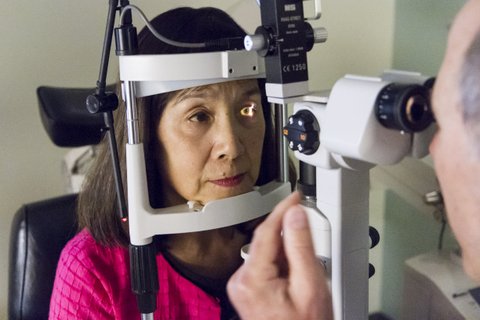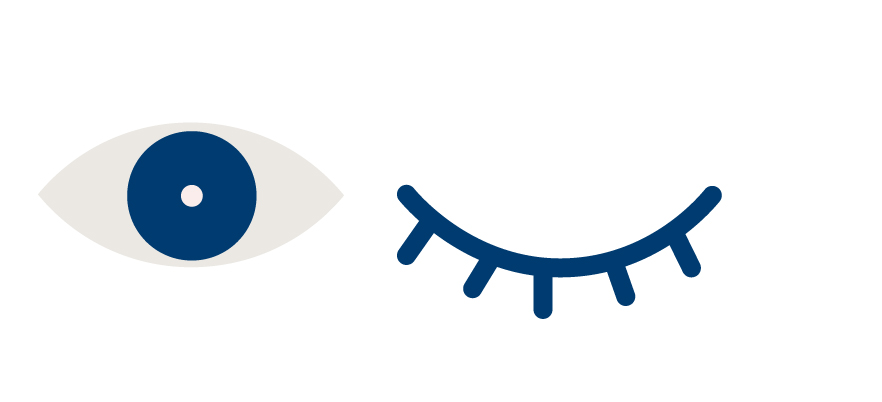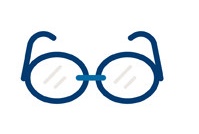Eye Health
Try to arrive 15 to 20 minutes early to your eye exam to allow time to check in and update your information.
Let your optometrist know if you are interested in getting contact lenses. Fitting contacts involves scheduling a separate appointment and additional fee to evaluate, fit you, and finalize your contact lenses. If you already use contact lenses, wear them to your appointment. Bring your eyeglasses and information about your current contacts, such as boxes, vials and your last prescription.
Your optometrist will perform a series of tests and examinations to see if your eyes are healthy. Conditions that can be detected during your eye exam include cataracts, glaucoma, macular degeneration, and diabetic retinopathy.
The optometrist will use a familiar eye chart to check for vision correction. You will receive a prescription for corrective lenses, if needed, that you can take to our optical shops for new eyewear.
| How often do I need eye exams? |
|
As a rule, you should not go more than two years without having your eyes examined. Diabetic patients, people with a family history of eye diseases, and anyone whose general health is poor or who are taking medications that may have potential side effects on the eyes, may need an eye exam at least once a year. Your eye doctor will help determine the eye exam schedule that meets your needs. |
| Do I need a special eye exam as I get close to, or past, age 40? |
|
You don’t need a special eye exam over age 40, but it’s critical that you have regular eye exams at least every two years. As we get older, it’s normal to have difficulty reading without glasses. We’re also more susceptible to certain eye diseases such as cataracts, glaucoma and macular degeneration. |
Schedule an eye exam now.
Although dilation is not always performed, please expect to be dilated as part of a complete eye examination. Drops are used to temporarily enlarge your pupils, which enables your eye doctor to get a better look inside your eyes. This allows our doctor to check for diseases such as cataracts, glaucoma and macular degeneration. Dilated eyes are more sensitive to sunlight, so it’s helpful to bring sunglasses to wear afterwards. Some people find it difficult to drive safely after dilation so you might bring someone to drive you home.

- Cataract-clouding of all or part of the lens inside the eye resulting in blurred or distorted vision.
- Glaucoma-disease in which internal pressure in the eye builds up because of problems with the outflow or drainage of fluid within the eye, damaging the optic nerve and causing partial or total loss of sight.
- Macular Degeneration-loss of central vision because of changes, often related to aging, in the macula—that portion of the retina responsible for sharp, clear central vision.
A retinal eye exam is needed once a year if you’ve been diagnosed with diabetic retinopathy, and usually every other year if you haven’t. The exam uses a high-quality digital camera. It’s fast and easy, and you don’t need to have your eyes dilated.

You can get a screening as part of an in-person visit at all Kaiser Permanente medical offices. Ask at the front desk to be directed to the diabetic retinopathy screening location. Find a clinic near you.
You can also get a screening as part of a complete eye exam at all our Eye Care locations. Your eyes will be dilated for this exam. Make an appointment.
Children are screened from birth for eye disease and vision problems by their pediatricians during their regular periodic visits. Any concerns will be referred to Kaiser Permanente eye doctor.
Parents are an important part of this process and need to let the pediatrician know if they notice anything unusual about their child's eyes or vision. The most common childhood eye problems are strabismus and amblyopia. Children, even infants, may require eyeglasses to correct vision problems.

Kids should have their first eye exam before starting school. Follow-up exams should be done every 2-4 years until age 20. Myopia or near-sightedness, which has become more common in kids can be addressed with glasses or the progression slowed with treatments such as MiSight contact lenses. Talk about myopia treatment options with your Kaiser Permanente eye doctor.
- Strabismus refers to a crossed or turned eye. This condition tends to run in families but also can occur spontaneously. Strabismus may require eyeglasses, or much less commonly, surgery.
- Pseudostrabismus refers to the very common situation where a child appears to have eyes that turn in due to a wide band of skin at the immature bridge of the nose. As the nose grows out, the appearance corrects itself.
- Amblyopia or "lazy eye" refers to an eye that doesn't develop vision equal to the other eye because it's deprived of visual input. This deprivation may be due to the eye being turned in or out, a droopy lid blocking light from entering the eye, or from a very different eyeglass lens prescription compared to the other eye. Treatment of amblyopia may require "patching," eyedrops, or eyeglasses.
Spending too much time in front of your phone or laptop can lead to tired, dry, overworked eyes, and other annoyances like eye twitching, headaches, and blurred vision. Here are a few easy ways to keep digital eye strain at bay:
This lubricates your eyes naturally. If the air in your work environment is dry, try using artificial tears throughout the day. Make sure it’s the lubricating type, not the redness reducing variety.

| Follow the 20-20-20 rule. |
| Every 20 minutes, take a 20 second break and look at an object 20 feet away. |
Aim to minimize harsh overhead light or bright sunlight from a window. If possible, position your computer screen so windows are to the side, instead of in front or behind your screen. Try turning off overhead fluorescent lights and use a floor lamp instead. Position a desk lamp so it’s shining on your desk, not in your eyes. If glare is a problem, install an anti-glare screen on your monitor. Also if you wear glasses, anti-reflective (AR) coatings can help reduce glare.

Situate your monitor at least 20-24 inches from your eyes with the center of the screen slightly below your eye line. Make sure the screen has proper brightness for your work space—approximately the same brightness as your surrounding area. Black type on a white background provides the best contrast, but other dark-on-light combinations also work.
Try reducing the amount of blue color on your screen. Blue light is a short-wavelengthlight associated with more eye strain than other longer wavelength hues like red and orange.

Glasses with blue-light-filtering lenses are available with or without a prescription to help reduce blue light exposure from computers and phone screens.
Short, frequent breaks from your computer are good for both your eyes and your whole body.
Bifocal or progressive lenses are not always optimal for the distance to your computer screen, but customized computer lenses are. Ask your eye doctor or optician about them.

While there are various causes of cataracts, most are a common and natural part of aging. The usually clear lens in your eye, becomes cloudy like looking through a foggy window. Cataracts often happen gradually and only need to be removed when they’re causing significant vision loss that affects your daily activities.
The best way to tell it’s time for cataract surgery is to have an eye doctor track your eyes’ progression. Here are 5 signs you can watch for:
- Hard to see in the dark
- Everyday activities like reading often become more difficult. When cataracts are advanced, you’ll need a bright light to see the words on the page clearly. Also, night driving becomes much more difficult. These are good indicators that you should consider cataract surgery.
- Sensitivity to bright light
Besides having difficulty seeing in the dark, cataracts make you sensitive to light. Sunlight or bright indoor lighting may cause pain.

- Faded colors or yellow hue
- Halos
When you have cataracts, you’ll notice that your vision is tinted yellow or brown. After cataract surgery, many patients comment that colors look brighter.
You may experience halos around light sources like headlights or streetlamps. It’s common to feel blinded by oncoming traffic, making night driving more dangerous. If you do not feel safe to drive, please don’t.
- Double vision
- Cataracts also can cause double vision because light coming through your lens becomes scattered. Driving at night while experiencing halos and double vision can be unsafe! This is just one way cataract surgery can make a big difference.

If you’re noticing changes to your vision, make an appointment with a Kaiser Permanente eye doctor who can help you decide if it’s time for cataract surgery. Cataract surgery is surprisingly quick and highly successful.
Kaiser Permanente offers access to over 4,000 searchable health topics, including a “Symptom checker” for some conditions. You can find articles on color blindness to cataracts to different kinds of eye drops. Search health topics.